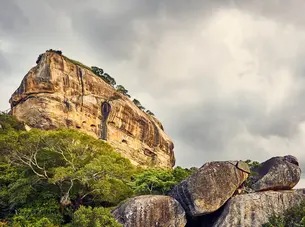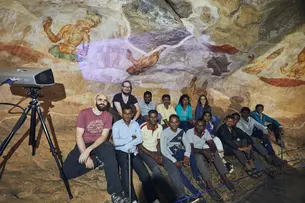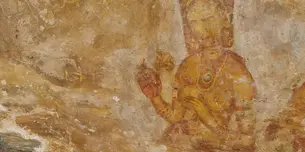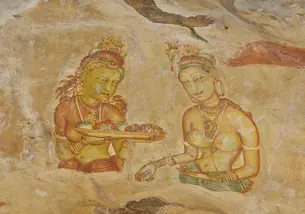Sigiriya Paintings - Digitisation, Documentation and Conservation of Endangered Wall Paintings in Sri Lanka
Content and aims
180 km away from the capital of Sri Lanka, in the middle of the country, the ancient site of Sigiriya is located. The site is named after the monolithic rock that reaches almost 200 metres above the surrounding landscape. Its name derives from "Singha Giri", which means "lion rock". At this place the Sinhalese king Kashyapa I. built his royal palace and made Sigiriya the capital and the cultural centre of the island during his reign from 473 - 495 A.D.
He built a winter palace on top of the plateau of the prominent lion's rock with a wide view over the country. At the foot of the rock he built an extensive complex consisting of a summer palace, terraces and parks with pleasure gardens and sophisticated water fountains, but also fortification rings with high walls, ramparts and moats.
Due to the historical significance of the place for the country, UNESCO declared Sigiriya a World Heritage Site in 1982. The declaration included the significant monumental frescoes that originally extended over an area of 140 m in length and 40 m in height on the western main side of the rock at a height of 100 m above the ground. Inscriptions mention that the paintings presented a landscape of sky and clouds; giving the impression the rock palace is hovering in the clouds. According to the inscriptions, more than 500 drawings of figures where shown in the cloud landscape. Under a rock ledge, protected from the heavy rains of the monsoons, some of the filigree, high quality paintings with 22 colourful, depictions of women have survived.
Observations by ICCROM and CCF, Sri Lanka, revealed that the wall paintings are severely endangered, caused by the aging of a conservation material used 35 years ago and the effects of the extensive visitor traffic. As a basis to prevent the loss of this important cultural asset, ICCROM recommended a 3D documentation of both, the Sigiriya paintings and the entire rock fa?ade. On this, a concept for conservation and preventive conservation measures need to be developed.
Thanks to the support of the Gerda Henkel Foundation and the CCF, the project to document and examine the paintings in detail was initiated in 2018. During the first campaign in October and November 2018, a precise 3D documentation of the wall paintings under the rock ledge was carried out in collaboration with the University of Kelaniya and members of CCF and DoA. In addition, two rock shelters with paintings from the 13th and 14th centuries of the more recent monastic use of the complex were documented.
The collected data is the basis for a condition and damage mapping, which will be carried out in the second campaign. At the same time additional investigations by the use of multispectral imaging (UV-VIS-IR photography, as well as IR thermography) and a drone-based documentation of the rock fa?ade will be done. The research will be supported by the micro-sample analysis to record the degradation processes of the aged conservation material to provide recommendations for conservation.
Project team
Project leader: Prof. Dr. Rainer Drewello
Project members in Bamberg: Max Rahrig, M.A. (coordinator); Katrin Vill, M.A.; Eva Basse, M.A.; Anna Luib, M.A.; Dr.-Ing. Tobias Arera-Rütenik; Dipl.-Rest. Eva H?fle and David H?pfner (photographer)
Participants from Sri Lanka of first campaign in 2018: Retd. Prof. Bilinda D. Nandadewa (University of Kelaniya); Ajith Jayasundara M.Sc. (CCF, Assistant Director Scientific and Research); Dias Wagachchi M.Sc. (CCF, Assistant Director Scientific and Research); Mithrananda Dharmasiri M.Sc.(CCF, Senior Chemical Conservator); Menika Rodrigo M.Sc. (CCF, Artefact Conservator); Lalith Kumarasiri (CCF, Painting Conservator); Sunera Yatawatta (CCF, Training Painting Conservator); Prema Kumara Herath (CCF, Training Painting Conservator); Shiromi Anuruddhika Rathnayake (CCF, Training Painting Conservator); Dhanuka Udayange B.A. (DoA, Development Officer); Thushara Dammika Herath (DoA, Conservation CR), Nilanta Pramalal (DoA, Conservation CR).
Duration: since october 2018
Pictures
Click on pictures to enlarge them.






